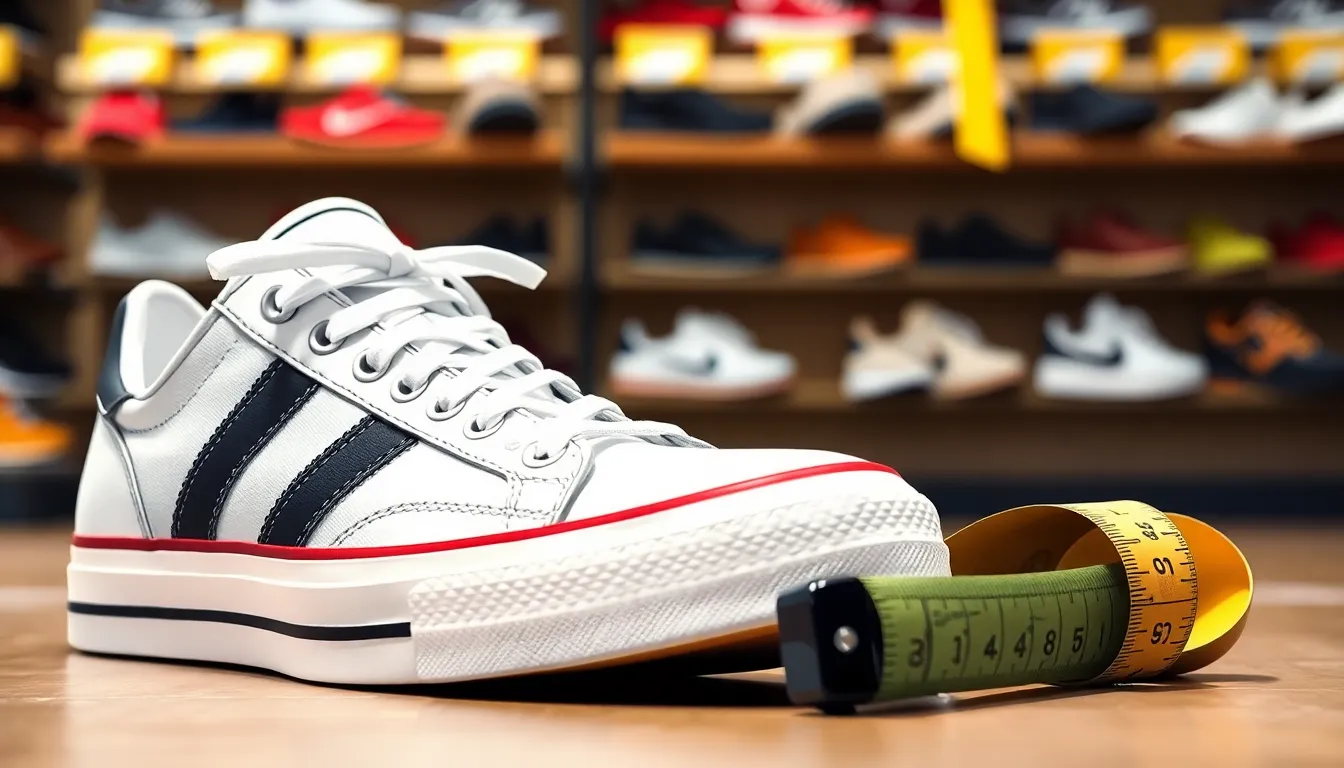Navigating the world of shoe sizes can feel like trying to solve a Rubik’s Cube blindfolded. When it comes to converting EU shoe sizes to US men’s sizes, confusion often reigns supreme. One minute you think you’re a size 42, and the next, you’re left wondering if you should be shopping in the kids’ aisle. Fear not, because understanding this conversion is easier than finding a matching sock in the dryer.
Table of Contents
ToggleUnderstanding EU Shoe Sizes
Grasping the EU shoe size system clarifies the conversion to US men’s sizes. European sizes differ from those in the United States, presenting a challenge for shoppers.
What Are EU Shoe Sizes?
EU shoe sizes, also known as European shoe sizes, use a unique numerical system. Ranging typically from 35 to 50, these sizes represent the length of the foot in centimeters. This measurement differs from the US system, which denotes size based on length in inches. For instance, men’s EU sizes generally start from 39, corresponding to a foot length of about 24.5 centimeters. During shopping, knowing this sizing framework helps men find the right fit for their shoes.
Comparison with US Shoe Sizes
Comparing EU and US shoe sizes reveals a consistent conversion chart. US men’s sizes usually run about 1.5 sizes larger than their EU counterparts. For example, an EU 42 generally equates to a US 9.5. Each size conversion varies slightly based on different brands and styles, impacting the overall fit. Understanding these differences enables shoppers to make informed decisions while navigating international footwear options.
Conversion Process for EU to US Shoe Sizes

Understanding the conversion process from EU to US shoe sizes simplifies choices for international shoppers. This section focuses on practical methods and tools for accurate conversions.
How to Convert EU Shoe Sizes
To convert EU shoe sizes, begin by using the general guideline that US men’s sizes are approximately 1.5 sizes larger than their EU equivalents. For instance, an EU size 42 corresponds to a US size 9.5. Start with the EU size, then deduct 1.5 to find the US size. If the size doesn’t match perfectly, refer to specific brand charts, as sizing can vary. Remember, foot length in centimeters often helps clarify size discrepancies. Measuring your foot length and comparing it to size charts provides additional accuracy.
Tools and Resources for Conversion
Several tools and resources assist in converting EU shoe sizes to US sizes effectively. Online size converters allow quick lookups, providing instant results. Size conversion charts from reputable footwear brands help verify the correct sizes. Mobile apps also offer convenient on-the-go conversion, making the process accessible anytime, anywhere. Retailer websites often feature visual guides for pairing EU with US sizes. Leverage these resources to ensure footwear fits well, eliminating uncertainty during international purchases.
Differences in Sizing Across Brands
Shoe sizing differences can significantly impact fit. Brands often use distinct lasts, affecting the overall size and width of shoes.
Brand-Specific Size Variations
Nike, Adidas, and Puma exemplify the diversity in sizing. Nike tends to run a half size smaller than usual, while Adidas often fits true to size. Puma may vary, depending on the shoe model. Some European brands, like Clarks and Geox, also display discrepancies in their sizes. These differences highlight the importance of checking brand-specific sizing charts before purchasing.
Tips for Finding the Right Fit
Start by measuring foot length in centimeters. Use this measurement alongside the EU size to determine the US equivalent. Always consult the size chart of the specific brand, as it provides crucial insights into size variations. If the shoe is available, try it on or look for a retailer with a good return policy. Reading customer reviews can also reveal insights about fit and comfort.
The Importance of Proper Shoe Sizing
Proper shoe sizing plays a crucial role in enhancing comfort and health. Wearing the correct shoe size prevents discomfort and potential foot problems. Issues like blisters, calluses, and foot pain arise often due to improper sizing. Accurate fit ensures that feet have enough room to breathe while preventing unnecessary friction.
Impacts on Comfort and Health
Comfort directly correlates with shoe fit. Shoes that are either too tight or too loose can lead to serious foot issues. Tight shoes compress the toes, resulting in pain or conditions like bunions. Loose shoes may cause slipping, leading to blisters or falls. Proper sizing also affects posture and balance, promoting a healthier gait. Choosing the right size reduces long-term foot problems, enhancing overall foot health.
Choosing the Right Shoe for Activities
Activity type influences the choice of shoes considerably. For running, shoes must provide adequate cushioning and arch support. Walking shoes focus on comfort and flexibility, allowing for natural foot movement. Different sports require specific shoe designs to ensure performance; for example, basketball shoes offer ankle support. Understanding the intended activity helps in selecting the right shoe, ultimately optimizing comfort and performance during various tasks.
Navigating the conversion from EU shoe sizes to US men’s sizes doesn’t have to be a daunting task. With a clear understanding of the differences in sizing systems and the tools available for assistance, shoppers can confidently make informed decisions.
By remembering the general rule of deducting 1.5 from the EU size to find the US equivalent and consulting brand-specific charts, individuals can ensure a better fit. Prioritizing proper shoe sizing is essential for comfort and foot health, preventing issues that arise from wearing ill-fitting shoes.
With these insights in mind, finding the perfect pair of shoes becomes a simpler and more enjoyable experience.



